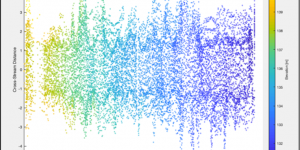Full Report here: G406_TermProject_SimonCampbell
Analysis of river-bed surface structure has important implications in the characterization of streambed morphology and channel morphodynamics. In particular, channel bed-surface roughness influences the size and morphology of small mountain streams by its interrelations with sediment transport, channel flow, as well as its influence on channel stability. Recognizing the appropriate conditions to describe channel stability remains a major challenge in streambed characterization, as the precise relationship between channel stability and channel roughness is unclear. The standard deviation of measured bed-surface elevations has been shown to describe the characteristic bed-surface roughness on a relative vertical scale. In particular, streambed elevation profiles can be created from multiple stream channel cross-sections, from which the standard deviation can be calculated and used as a proxy for bed roughness. This project uses channel bed elevation data that was surveyed in three riffle-pool reaches of a small mountain creek in Southwestern British Columbia from 2003 – 2015. The annual standard deviation of minimum value elevations in multiple channel cross-sections are used to define a characteristic roughness scale for this length of the channel. Estimations of bed-surface roughness are compared over time and correlated with previous records of streamflow but failed to correlate with sediment flux and bed elevation changes in an attempt to validate our methodology, which pointed to the importance of considering scale-dependent channel processes in analyzing channel morphodynamics. We recommend that bed roughness at the reach-scale may be better able to represent sporadic changes occurring in more localized areas, that are not evident in our roughness proxy.


Learning Significance